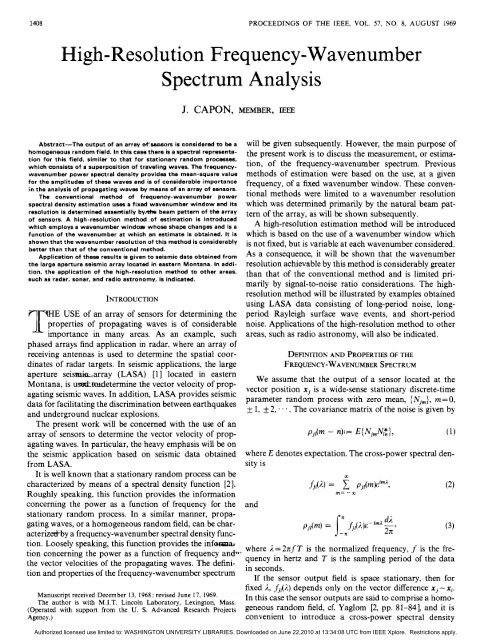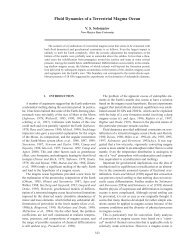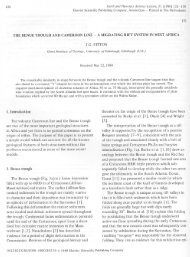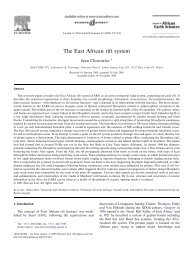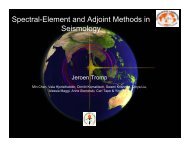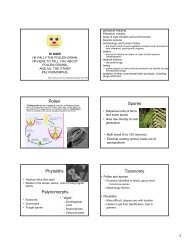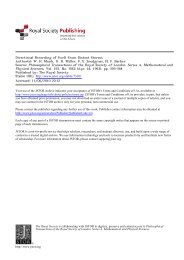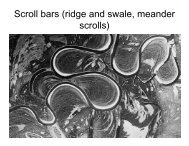High-Resolution Frequency-Wavenumber Spectrum Analysis
High-Resolution Frequency-Wavenumber Spectrum Analysis
High-Resolution Frequency-Wavenumber Spectrum Analysis
- No tags were found...
You also want an ePaper? Increase the reach of your titles
YUMPU automatically turns print PDFs into web optimized ePapers that Google loves.
1408 PROCEEDINGS OF THE IEEE, VOL. 57, NO. 8, AUGUST 1969<strong>High</strong>-<strong>Resolution</strong> <strong>Frequency</strong>-<strong>Wavenumber</strong><strong>Spectrum</strong> <strong>Analysis</strong>Abstract-The output of an array bfoensors is considered to be ahomogeneous random field. In this case there is a spectral representationfor this field, similar to that for stationary random processes,which consists of a superposition of traveling waves. The frequencywavenumberpower spectral density provides the mean-square valuefor the amplitudes of these waves and is of considerable importancein the analysis of propagating waves by means of an array of sensors.The conventional method of frequency-wavenumber powerspectral density estimation uses a fixed wavenumber window and itsresolution is determined esserrtially by& beam pattern of the arrayof sensors. A high-resolution method-of estimation is introducedwhich employs a wavenumber windoar whose shape changes and is afunction of the wavenumber at which an estimate is obtained. It isshown that the wavenumber resolution of this method is considerablybetter than that of the conventional method.Application of these results is given to seismic data obtained fromthe large apenure seismic array located in eastern Montana. In addition,the application of the high-resolution method to other areas,such as radar, sonar, and radio astronomy, is indicated.will be given subsequently. However, the main purpose ofthe present work is to discuss the measurement, or estimation,of the frequency-wavenumber spectrum. Previousmethods of estimation were based on the use, at a givenfrequency, of a fixed wavenumber window. These conventionalmethods were limited to a wavenumber resolutionwhich was determined primarily by the natural beam patternof the array, as will be shown subsequently.A high-resolution estimation method will be introducedwhich is based on the use of a wavenumber window whichis not fixed, but is variable at each wavenumber considered.As a consequence, it will be shown that the wavenumberresolution achievable by this method is considerably greaterthan that of the conventional method and is limited primarilyby signal-to-noise ratio considerations. The high-INTRODUCTIONresolution method will be illustrated by examples obtainedusing LASA data consisting of long-period noise, long-THE USE of an array of sensors for determining the period Rayleigh surface wave events, and short-periodproperties of propagating waves is of considerable noise. Applications of the high-resolution method to otherimportance in many areas. -As an example, such areas, such as radio astronomy, will also be indicated.phased arrays find application in radar, where an array ofreceiving antennas is used to determine the spatial coor-DEFINITION AND PROPERTIES OF THEdinates of radar targets. In seismic applications, the largeFREQUENCY-WAVENUMBER SPECTRUMaperture seis&array (LASA) [l] located in easternWe assume that the output of a sensor located at theMontana, is udtwietermine the vector velocity of propvectorposition xj is a wide-sense stationary discrete-timeagating seismic waves. In addition, LASA provides seismicparameter random process withzero mean, (Njm}, m=O,data for facilitating the discrimination between earthquakes-t 1, k 2, .*. . The covariance matrix of the noise is given byand underground nuclear explosions.The present work will be concerned with the use of anarray of sensors to determine the vector velocity of propagatingwaves. In particular, the heavy emphasis will be onpjAm - n)1= E{NjmNZ}, (1)the seismic application based on seismic data obtained where E denotes expectation. The cross-power spectral denfromLASA.sity isIt is well known that a stationary random process can beXcharacterized by means of a spectral density function [2].&(I.) = pjl(m)Eim', (2)Roughly speaking, this function provides the informationm= -.aconcerning the power as a function of frequencyfor the andstationary random process. In a similar manner, propadigating waves, or a homogeneous random field, can be char-pjr(m) = fjl(I.)E-im' -2acterizdby a frequency-wavenumber spectral density func-l n 211 (3)tion. Loosely speaking, this function provides the info--.. where i=2xfT is the normalized frequency, f is the fretionconcerning the power as a function of frequency an&..quency in hertz and T is the sampling period of the datathe vector velocities of the propagating waves. The definiinseconds.tion and properties of the frequency-wavenumber spectrumIf the sensor output field is space stationary, then forfixed i, &(E.) depends only on the vector difference xj- xl.Manuscript received December 13, 1968; revised June 17, 1969.In this case the sensor outputs are said to comprise a homo-The author is with M.I.T. Lincoln Laboratory, Lexington, Mass.(Omrated with SUDDOIT ._ from the U. S. Advanced Research Proiects geneous random field, Cf. Yaglom [2, PP. 81-84], and it isconvenient to introduce a cross-power spectral densityAgency.)Authorized licensed use limited to: WASHINGTON UNIVERSITY LIBRARIES. Downloaded on June 22,2010 at 13:34:08 UTC from IEEE Xplore. Restrictions apply.
CAPON: FREQUENCY-WAVENUMBER SPECTRUM ANALYSIS 1409f(i, r) and cross-covariance p(m, r) asf(& r) = fil(4, (4)dm, r) = pjt(m), (5)whenever xj - xI = r.Following Yaglom, [2, pp. 81-84], any homogeneousrandom field has a spectral representationNjm = /IRj:zj:z&-i(mi+k'x. l)Z(d;.. dk) (6)where k is the vector wavenumber. We have that Z(A& Ak)is a random function of the frequency interval A2 and theelemental wavenumber area, or interval Ak, with the followingproperties :1) E(Z(Ai., Ak)) =0, for all Ai, Ak ;2) Z(Ai.,Alk+A2k)=Z(Ai,Alk)+Z(fi.,Azk),ifAlkandA2k are disjoint intervals, and Z(A,;.+A2i., Ak)=Z(Ali, Ak)+Z(A2L, Ak) if AI;. and A2j. are disjointintervals ;3) E{Z(AIE., Alk)Z*(A2j., A2k)}=0, if A,k and A,k aredisjoint intervals, or if A,;. and A,;. are disjoint intervals;4) E{JZ(Ai., Ak)12) = P(i, k)(Ai/2n) Ak,Ak,,where P(i, k) is the frequency-wavenumber power spectraldensity function and 2nk,, 2nk,. are the x, 4' components,respectively, of the vector k in radians per kilometer. Itshould be noted that Z(Aj., Ak) is a random function withuncorrelated increments, where the increments can betaken either in frequency i, or in vector wavenumber k.The cross-covariance and cross-power spectral density canbe written asJ-RJ-zJ-IIt is possible to write the frequency-wavenumber spectrumasIP(i, k) = 1% p(m, r)&i(mA+k'r) dr,dr,ill(27t)-'P(;., k) = f:zf:z6(i= 6(i - j.0, k - ko)- i o) exp [i(k - k,). r]drJr,which is a delta function located at the frequency i., =2n foTand wavenumber k,. It should now be apparent how P(i, k)provides the information concerning the speed and azimuth,or vector velocity, of propagating waves.CONVENTIONAL METHOD FOR ESTIMATINGFREQUENCY-WAVENUMBER SPECTRUMWe now assume that K sensors are to be used to estimatethe frequency-wavenumber spectrum P(i, k). Such an estimateis usually based on an estimate for the cross-powerspectral density fj,(i.). For simplicity, only the direct segment,or block averaging, method of estimation will beconsidered for estimating &,(E,). It has been shown [3] thatthis method is very desirable from the point of view of computationalefficiency. There is also no essential loss of generalityin considering a specific estimation method for j&).In the direct segment method the number of data points Lin each channel is divided into M nonoverlapping blocks ofN data points, L = MN. The Fourier transform of the datain the nth segment, jth channel, and normalized frequencyi., isS,,,(E.) = (N)-1.2Mm=l. .amNj,,+~n-l~N~'m'~ j = 1, . . ., K (10)n = I;..,M.The a, are weights which are used to control the shape of thefrequency window used in estimating fjl(i). Again, forsimplicity, we assume a, = 1, m = 1, .. ., N. As an estimate forf,,(i) we takel M&E.) = - s~,,(;~)s:(>.),M ,,= 1j, I = I, ' . . , K. (11)We will assume hereafter that a normalization is performedby dividing &(i) by [&(j.)lI(j.)]1/2, in order to remove theeffects of improper sensor equalization. We can, withoutany loss of generality, ignore this step in the ensuing analysis.As an estimate for PO., k) we taker KJ-zJ-mJ-zIWN(X - ;.)I2dx- dk,dk,271(131~,Authorized licensed use limited to: WASHINGTON UNIVERSITY LIBRARIES. Downloaded on June 22,2010 at 13:34:08 UTC from IEEE Xplore. Restrictions apply.
1410 PROCEEDINGS OF THE IEEE, AUGUST 1969where ~W,(X)(’ is the Bartlett windowand lB(k)I’ is the beamforming array response patternl KB(k) = - 1 ‘=j. (15)K j =1Thus, E{P(I., k,)) is obtained by means of a frequencywavenumberwindow IW,(x-R)I2. IB(k-k,)l’. Hence,. Pwill be an. asymptotmdly unbiased estimate for cP ifI WN(x - 1) .B(k- kO)l’ approaches a delta function in .sucha way thatUsing the results of [3] we can compute the variance of Pas, assuming {PIj,} is a multidimensional Gaussian process,Thus,1VAR {P(i,k,)} =- {E[P(A,ko)]}2MP(x, k)B*(k - k,)B(k + E,)dxI W,(X - A)/’ - dk,dk,2n1VAR {P(A, k,)} 2 -{E[p(Eb, ko)]}2, lkol # 0ML= -{E[P(;., k,)])’, lkol = 0.M(16)Since the variance of P approaches zero as M approachesinfinity, it follows that P is a consistent estimate for cP.We follow Blackman n d Tukey [4] and assume thatP(I., k,) is a multiple of a chi-square variable so that toestablish confidence intervals the chi-square distributioncan be used with the number of degrees of freedom k given byk = 2{E[P(E., k,)])’/VAR [&, k,)]= 2” lkol # 0 (17)= M, lkol = 0,if M = 36, k = 72, and the 90 percent confidence limits areapproximately _+ 1.2 dB, and if lk,l ZO. When lkol =0, theselimits are approximately 1.6 dB.HIGH-RESOLUTION METHOD FOR ESTIMATINGFREQUENCY-WAVENUMBER SPECTRUMThe high-resolution estimate for P(2, k) is defined asC‘P’(1, k) = gjl(i) exp [ik .(xj- xl)],I = 1 ]-I (18)where {gjl(I.)} is the inverse of the spectral matrix {&I.)}.The motivation for this procedure can be given by writing(18) asKP‘(E,, k) = 1 Aj*(/,, k)A,(I., k)A,(I.) exp [ik .(xj- x/)]wherej,l= 11 M I KM n=lA;(& k)S,(I.) exp [ikand {qij(J., k)} is the inverse of the matrix (exp [ik .(xj-xl)]$,(I.)}. Thus, P‘(;., k,) is the power output of an arrayprocessor, known as a maximum-likelihood filter, whosedesign is determined by the sensor data and is different foreach wavenumber k,, which passes undistorted any monochromaticplane wave traveling at a velocity correspondingto the wavenumber ko and suppresses in an optimum leastsquaressense the power of those waves traveling at velocitiescorresponding to wavenumbers other than k,, cf. [3, (122)and (123)l. It should be noted that the amount of computationrequired to obtain P’ is almost the same as that to getp, since only an additional Hermitian matrix inversion isrequired.We now wish to compute the mean and varidP’.In order to do this we assume that M, N are large enough sothat as an approximation we may replace &(Eb) by &(A)in the definition for Aj(,i, k) in (20). This then implies thatthe weights A,()., k) are not random and can be replaced bytheir expected values. This is a simplifying assumption,which is not actually valid, since these weights are designedfrom the data. However, it does appear to be a reasonableapproximation. Using this assumption we havewhereE{P’(i, k,)) = j:zjIm J:mp(x, k)l WN(x - j-1(211KB’(j-, k, ko) = A,@, k,) exp [i(k- k,) . xi]. (22)j= 1It should be noted that the functional form, or shape, of B’changes as a function of the wavenumber k,. Thus,E(P‘(1, k,)} is obtained by means of a frequency-wavenumber.windowIWN(x-j.). B’(j., k, k,)(’. Hence, P‘ will bean asymptotically unbiased estimate for cP if IW,(x- 2)* B’(Iv, k, k,)/’ approaches a 3-dimensional delta functionin such a way thatwhere c is some positive number.Authorized licensed use limited to: WASHINGTON UNIVERSITY LIBRARIES. Downloaded on June 22,2010 at 13:34:08 UTC from IEEE Xplore. Restrictions apply.
CAPON: FREQUENCY-WAVENUMBER SPECTRUM ANALYSIS 1411The variance of P’ is, assuming (Njm} is a multidimensionalGaussian process,1VAR {P’().,ko)) = -(E[P’(i,ko)]}2+ -M. P(x, k)B’*(i, k, ko)B’()., k, - k,) (24)Thus,dx. I @$(X - ;.)I2 - dk,dk,.2n1VAR {P’(i., ko)} z - /E[P’(i, ko)]}’, lkol # 0ML-_ - (E[P’(E., k,)])’, lkol = 0..21(25)The confidence limits for P‘ can be obtained in a mannersimilar to that for ii described previously.It will now be shown that the wavenumber resolutionusing P’ is higher than that obtained by using P. We assumethat a single plane wave is propagating across the array ofsensors and that a noise component is present in each sensorwhich is incoherent between any pair of sensors. If M, N arelarge, then the spectral matrix is given by+&(E.,)where= 6,(R) exp [- ik, .(xj- x,)], j, 1 = 1, . . ., K (26)R is the ratio of the incoherent noisepower to the totalpower of the sensor output, k, = 2nf,a, fb is the frequency,E., = 2nf,T, T is the sampling period, -a is the slownessvector which points in the direction of propagation and hasmagnitude 1 x 1 = lk, c’ is the phase velocity of the propagatingwave. Hence, using (12) we havewhereP(Ebo,Rk) = (1- R)lB(Ako)12 + -K(28)matrix whose j lth element is exp [ -ik,. xj]. Now wehave the following matrix inversion formulaso that using (18) we haveIf k = k,, thenR 1 - R + (R/K)P’(j.0, k) = -K 1 - R + 2(R/K) - f‘(E.,, k) . (32)Rf‘(E.,, k,) = k,) = 1 - R + -.K(33)In the vicinity of k= k, we consider that power contour, orthose values of k, for which &20, k)= 1 - R, which is stillvery close to the peak value of 1 - R +(R/K), since R issmall, between zero and unity, and K is large, usually about20. For these values of k we get P‘(io, k)=gl- R + R/K),so that P‘ is already 3 dB down from its peak value of1 - R + R/K. Hence, the wavenumber resolution using P’will be much higher than that obtained with f‘.We now assume that there are two independent andrandom plane waves propagating across the array of sensors,plus incoherent noise, so that the spectral matrix is= d qi + 4;q2 + RI (34)where 41, 42 are 1 x K row matrices whose 1 jth elementsare, respectively, b, exp [ik, .xj] and b, exp [ik, .xj], andb: + b: + R = 1. We now have2k) = bjlB(Akj)I2 + -3j= 1 K&io,R(35)If we denote the matrix given in (26) by F, thenUsing this formula, as well as that given in (31) we obtain[P’(i,, k)]-’ = [P;(;.,,k)]-’ -(:yF = (1- R) q’q[+ ~1-R I].where I is the K x K identity matrix, q is a 1 x K row matrixwhose 1 jth element is exp [ik, . xj] and q‘ is a K x 1 columnwhere Akj, = kj - k, andRP;(E.,, k) = -KRb; + -K2RKbj + - - f‘j(i.0, k)j = 1,2, (38)Authorized licensed use limited to: WASHINGTON UNIVERSITY LIBRARIES. Downloaded on June 22,2010 at 13:34:08 UTC from IEEE Xplore. Restrictions apply.
1412 PROCEEDINGS OF TH€ IEEE, AUGUST 1969Rfjj(Ao, k) =. b;1B(Akj)l2 + -9 j = 1,2. (39)KThus -P;. is the high-resolution frequency-wavenumber spectrumobtained when only the jth propagating wave, plusincoherent noise, is present. In the vicinity of k=k, wewould like P’z Pi. Hence, the second term in (37) representsan undesired error term in this region which we would liketo be as small as possible. It can easily be shown that thiserror term will be small compared to 1/P; ifIn most cases R/K will be very small so that we may write(40) asThis inequality will be satisfied if either R/K is small,IB(Ak12)12 is small or both of these quantities are small. Itshould be noted that IB(Ak12)12 will be small if the wavenumberk, corresponding to one of the propagating wavesis sufficiently different from the wavenumber k2 of the otherpropagating wave. In this case the two propagating wavescan be resolved in wavenumber by the natural beam patternof the array of sensors, lB(k)I2. However, if IB(Ak12)12 is nottoo small, so that the natural beam pattern can-not resolvethe two waves, it is still possible for the high-resolutionmethod to resolve the two waves if R/K is small andIB(Ak12)12< 1. Thus, we see the advantage of the highresolutionmethod over the conventional method of frequency-wavenumberspectrum analysis. In a similar mannerwe may show that in the vicinity of k = k,, P’E P2 ifnegative-definite matrix when the block averaging methodof spectral estimation.is used [3]. However, this is not goodenough to insure that the inverse of the spectral matrixexists. That is, it must be shown that the spectral-matrix ispositive-definite in order that its inverse exist.In fact, if the number of blocks M is less than the numberof sensors K, then the spectral matrix is of order K, but onlyof rank M at most and is thus singular. This can be seen bywriting the spectral matrix F asn= 1where qn is a 1 x E; row matrix whose 1 jth element isNm= 1Thus, F is the sum of M matrices each having rank unity,and the rank of F cannot exceed the sum of the ranks,namely M. Hence, F has rank M at most and, if M
CAPON: FREQUENCY-WAVENUMBER SPECTRUM ANALYSIS 1413IW- 200 kmFig. 1. General arrangement of the large aperture seismic array.TABLE IPARAMETERS USED IN MEASUREMENT OF FREQUENCY-WAVENUMBER SPECTRUMDATAAddedSampling Array Nominal Number of <strong>Frequency</strong> Number of Confidence 90%AmountRate Aperture Number of Samples per <strong>Resolution</strong> Blocks = Limits Incoherent(Hz) (km) Sensors=K Block=N (Hz)(dB) Noise = RLPZ noise 1 200 21 0.0110036 * 1.2 0LPZ Raylei& surface-wave event(entire wave) 1 200 21 100 0.01 36 - 0LPZ Rayleigh surface-wave event(200 seconds at a 1 time) 200 21 100 0.01 2 - 0.05SP noise 10 36 25 100 0.10 36 & 1.2 0LASA consists of 21 subarrays of 25 short-period (SP)vertical seismometers as indicated in Fig. 1. At the center ofeach subarray there is a three-component set of long-period(LP) seismometers oriented in the vertical (Z). north-south(NS), and east-west (EW) directions.As mentioned previously. a direct segment. or block averaging,method of spectral estimation was employed. Theweights aj= 1, j= 1, .... N were used, cf. (IO) so that aBartlett frequency window was used in the spectral estimation[4]. The seismic data considered was LPZ noise, LPZRayleigh surface-wave events, and SP noise. The parametersused in the measurement are given in Table I. The results ofthe conventional frequency-wavenumber spectrum measurementprogram are displayed, at a fixed frequency, ascontours of - 10 log [P(i, k)/pmax] vs k,, k,, where P,,, isthe maximum value of P. The wavenumber coordinates arein cycles per kilometer. The wavenumber grid on which dis computed consists of 61 x 61 points. The level of the contoursvaries from 0 to 12 dB in steps of 1 dB. The display ofthe high-resolution results is similar to that of the conventionalresults with the only exception that the contour levelsare incremented by 2 dB. It should be noted that ifa wave ispropagating from the north with a velocity correspondingto the wavenumber k,, then the wavenumber spectrum resultswill show a peak at the point k,=O, k,=lk,,1/2nn, i.e.,the peak will appear above the origin of the wavenumberaxes.The transfer function of the LP system is shown in Fig. 2.The results of both the conventional and high-resolutionfrequency-wavenumber spectrum measurements for LPZAuthorized licensed use limited to: WASHINGTON UNIVERSITY LIBRARIES. Downloaded on June 22,2010 at 13:34:08 UTC from IEEE Xplore. Restrictions apply.
1414'"""EPROCEEDINGS OF THE IEEE, AUGUST 19691\0.4 I I I I I Ill1 I I I llllll I I I I I Ill10.ooi 0.0 t 0.1 i .oFREQUENCY ( Hz 1Fig. 2. Long-period system transfer function.noise are shown in Figs. 3 and 4 for two different noise samplestaken on 7 April 1967 and 26 January 1967, respectively.These figures show that the conventional and highresolutionresults are in agreement as both methods tend toshow strong peaks occurring at the same wavenumber ineach program. However, the high-resolution method delineatesthe frequency-wavenumber spectrum much moreclearly than the conventional method, especially in thesuppression of the sidelobe level. This is demonstrated quitewell in Fig. 4 which shows a 360" azimuthal spread for thewavenumber.structure with a variable power density alongthis circle. This is, of course, exactly what would be expectedsince the dispersion curve of the LPZ propagating seismicnoise has been measured and found to correspond to that ofa fundamental mode Rayleigh wave [5]. This implies thatat a given period the phase velocity of the propagating noiseat LASA must be constant, independent of the location ofthe sources of the noise, and thus its frequency-wavenumberspectrum must consist of an arc, or arcs, whose extent correspondsto the range of the azimuths of the noise sources.The results of Fig. 3 show the noise consists essentiallyof a single wave propagating from the north. In this case theconventional result should appear essentially the same as thebeam pattern of LASA, with the peak of the beam patternoccurring at the wavenumber corresponding to the vectorvelocity of the.propagating wave. That this is indeed thecase can be seen by comparing Fig. 3 with Fig. 5 whichshows the beam pattern of LASA. It should be noted thatfrequency-wavenumber spectra were computed for a theoreticalmodel of the LPZ noise and showed excellent agreementwith the measurements obtained using the actualLPZ seismic noise data. We also mention that the computerrunning time to produce a pair of plots, such as is shown inFig. 3, is approximately 10 minutes using the IBM 360/67.Another application of interest is to LPZ Rayleighsurface-wave events. In this case the propagating waves aretransients, in time, and the field of sensor outputs cannot beconsidered as a homogeneous random field, as is the casewith propagating. seismic noise waves. Therefore, thefrequency-wavenumber spectrum must be redefined in thiscase. Towards this end consider the time correlation.functionT ApjXm) = LIMIT- Nj,,A71,n-m.A+oc 2An=-,4The spectral densities fjl(A), f(L, r) are defined in the samemanner as previously, cf. (2), (4), respectively, and the frequency-wavenumberspectral density PO., k) is also definedas previously in (9). The measurement of P(i., k) is still doneby the direct segment method as indicated in (12) and (18).This represents an approximation which produces reasonableresults. -The frequency-wavenumber spectrum was measured forthe-21 November1966 Kurile Islands event whose param-Authorized licensed use limited to: WASHINGTON UNIVERSITY LIBRARIES. Downloaded on June 22,2010 at 13:34:08 UTC from IEEE Xplore. Restrictions apply.
CAPON: FREQUENCY-WAVENUMBER SPECTRUM ANALYSIS 1415-%.-I i..
1416PROCEEDINGS OF THE IEEE, AUGUST 1969TABLE I1PAR.4hIETER.S FOR 21 NOVEMBER 1966 KURILE ISLANDS EVENTCONVENTlONAtNHIGH RESOLUTIONNDate : 21 November 1966Region :Kurile IslandsOrigin time: 12:19:27Latitude:46.7 NLongtude:152.5 EDistance:64.3'Azimuth: 312'Depth:40 kmBody-Wave Magpitude: 6.05WAVENUMBER (cyclerlhmlE W EFREQUENCY = 0.03 Hz(PI21 NOV 66KURILE ISLANDS EVENT12:40:00 T0..13:40:000SWAVENUMBER Icyckrlkm)CONVENTIONALNHIGH RESOLUTIONEW--21 NOV 66KURILE ISLANDS EVENTFig. 6. The long-period waveforms for 21 November 1966Kurile Islands event.eters are given in Table 11. TIE LPZ Rayleigh surface wavesof this event are shown in Fig. 6. The results obtained bymeasuring the frequency-wavenumber spectrum over theentire LPZ Rayleigh surface-wave train, as indicated inTable I, are given in Fig. 7 for frequencies of 0.03, 0.04,0.05 Hz. It is known that the beating, or modulation, of theenvelope of these surface waves, as shown in Fig. 6, is causedby multiple path propagation, especially at shorter periods,cf. [6]-[8]. This multipath propagation effect is shownquite clearly at 0.04 Hz where two peaks are resolvable. Onepeak is at an azimuth corresponding to the initial wavearriving along the great circle path between LASA and theKurile Islands, while the other peak shows the later multipatharrival propagating from the northwest.In order to determine the time-delay between the multipatharrivals at LASA, for the 25-second period group, thefrequency-wavenumber spectrum was measured over successive200-second-long blocks of time, as indicated inTable I. The results are given in Fig. 8, which, for simplicity,shows only the high-resolution results. Fig. 8(a) shows thatthe initial 25-second period group arrives from approximatelythe azimuth of the event, while Figs. 8(bHd) showthe later arrivals coming from a more northerly direction.The time delay between the multipath arrivals appears tobe about 200 seconds, since the emergence of a secondarypeak to the north is visible in Fig. 8(b). The group velocityfor these waves at the 25-second period is about 3.3 km/s sothat a path length difference of about 660 km or 6 degrees0 0.041 -OW5 0SSWAVENUMBER IcyckrltrnlWAVENUMBER (cyskrltmlFREOUENCY 0.04 Hz( b)21 NOV 66KURILE ISLANDS EVENT12:40:00 TO 13:40'00CONVENTIONALNIHIGH RESOLUTIONN0 W5E W E0 0 045SSWAVEWBER Icpkslkm)WAVENUMBER ~~hrltrnlFREPUENCY = 0.05 Hz(C)21 NOV 66KURILE ISLANDS EVENT12:40:00 TO 13:40:00Fig. 7. Conventional and high-resolution frequency-wavenumber spectrafor 21 November 1966 Kurile Islands event: 12:40:00 to 13:40:00.(a) <strong>Frequency</strong>=0.03 Hz.=0.05 Hz.(b) <strong>Frequency</strong>=0.04 Hz. (c) <strong>Frequency</strong>exists between the two multipath arrivals. Similar resultshave been obtained by Evernden by measuring phase velocitieswith a tripartite array [7], [8]. In addition, Everndengives a theory to explain the causes of the multipath propagationof Rayleigh surface waves.We now discuss the application of our results to SP noise.The transfer function of the SP system is shown in Fig. 9.Authorized licensed use limited to: WASHINGTON UNIVERSITY LIBRARIES. Downloaded on June 22,2010 at 13:34:08 UTC from IEEE Xplore. Restrictions apply.
CAPON: FREQUENCY-WAVENUMBER SPECTRUM ANALYSIS 1417N N HIGH RESOLUTIONNIWE-001. . ~,/ \ I 1,. .>45 0 0045 -OW5 0 0 0'sSWAVENUMBER (cycla/kmlWAVENUMBER (cycler/kml12:51:M) TO 12:54:20 12 54 M TO 1 2 57.40(a)FREOUENCY = 0.04 Hz21 NOV 66KURILE ISLANDS EVENT(b)SWWVENUMBER (cyola/krnl-915 L---+-4FREQUENCY = 0.2 Hz(0)1 FEE 67 NOISE SAMPLE08:03:00TO 08:09:M)SWNENuUyBR lcrclea/la)N N HIGH RESOWTIONN1 I pI-- I-OD45- 0045b,
‘ OClBl1418 PROCEEDINGS OF THE IEEE, AUGUST 1969W COC4BIo 84H6OB4’‘ 081% OBlHZOB4H40 AOHI OBIH4mG60 &l oAOG20 B3H6 0 A0D30~0~5 OAOH3o B3n4OBJH2otozH6OBPH4o B2H2oC281OC3HZ+OC381S[_ 36KMFig. 1 I. A subarray of short-period sensors.0 05-DEw o Ethis change in wavenumber window shape is performed in.an optimum manner, as pointed out previously. As a consequence,it has been shown that the wavenumber resolutionof this method is determined primarily by the amount ofincoherent noise which is present in the array of sensors,and, to a lesser extent, by the natural beam pattern of thearray.The experimental results show a considerable improvementof wavenumber resolution of the high-resolutionmethod relative to the conventional method. In the case ofLPZ seismic noise there was an improvement of about afactor of four, cf. Fig. 3. Thus, the high-resolution methodis extremely useful for the estimation of the frequencywavenumberspectrum when the incoherent noise power isrelatively small compared to the power of the propagatingwaves.The high-resolution method would, of course, be usefulin applications other than seismic arrays. We now mentionbriefly the application of the method to radio astronomy.It is now possible to synchronize the outputs recorded atseveral radio astronomy telescopes [9]. Thus, these telescopescan be considered as sensors in an array, (cf. [9,Fig. 11). If the incoherent noise power in each telescope issufficiently small, i.e., the radio signals from distant starsrecorded by the telescopes should be coherent and. thereshould be relatively little incoherent background noisepower, then the high-resolution method is directly applicablefor the purpose of using this array of telescopes tomap the sources of radio energy.-005-010-015-0.15 -010 -005 0 005 010 015SWAVENUMBER (cycles/krn)for the subarray of shortperiodsensors.Fig. 12. The beam patternventional method of estimation employs a fixed wavenumberwindow, and, as a consequence, the wavenumber resolutionis determined essentially by the natural beam patternof the array of sensors. The high-resolution method of estimationemploys a wavenumber window whose shape, andthus sidelobe structure, changes and is a function of thewavenumber at which an estimate is obtained. In addition,REFERENCES[l] P. E. Green, Jr., R. A. Frosch and C. F. Romney, “Principles of anexperimental large aperture seismic array (LASA),” Proc. IEEE,vol. 53, pp. 1821-1833, December 1965.[2] A. M. Yaglom, An Introduction to the Theory of Stationary RandomFunctions, Englewood Cliffs. N. J.: Prentice Hall, 1962.[3] J. Capon, R. J. Greenfield. and R. J. Kolker, “Multidimensionalmaximum-likelihood processing of a large aperture seismic array,”Proc. IEEE, vol. 55. pp. 192-21 I, February 1967.[4] R. B. Blackman and J. W. Tukey, The Measurement ofpower Spectrafrom the Point of Vie#. of Communication Engineering, New York:Dover Publications, 1959.[5] M. N. Toksijz and R. T. Lacoss. ”Microseisms: mode structure andsources.” Science, vol. 159. pp. 872-873, February 23. 1968.[6] W. L. Pilant and L. Knopoff. “Observations of multiple seismicevents.” Bull. Seismol. Soc. Am., vol. 54, pp 1Ck39, February 1964.[7] J. F. Evernden. “Direction of approach of Rayleigh waves and relatedproblems, Pt. I,” Bull. Seismol. Soc. Am., vol. 43, pp. 335-353,1953.[8] J. F. Evernden. “Direction of approach of Rayleigh waves and relatedproblems. Pt. 11,” Bull. Seismol. Soc. Am.. vol. 44, pp. 159-184,1954.(91 M. H. Cohen. D. L. Jauncey. K. I. Kellermann. and B. G. Clark.“Radio astronomy at one-thousandth second of arc.” Science. vol.162, pp. 88-94, October 4, 1968.Authorized licensed use limited to: WASHINGTON UNIVERSITY LIBRARIES. Downloaded on June 22,2010 at 13:34:08 UTC from IEEE Xplore. Restrictions apply.


